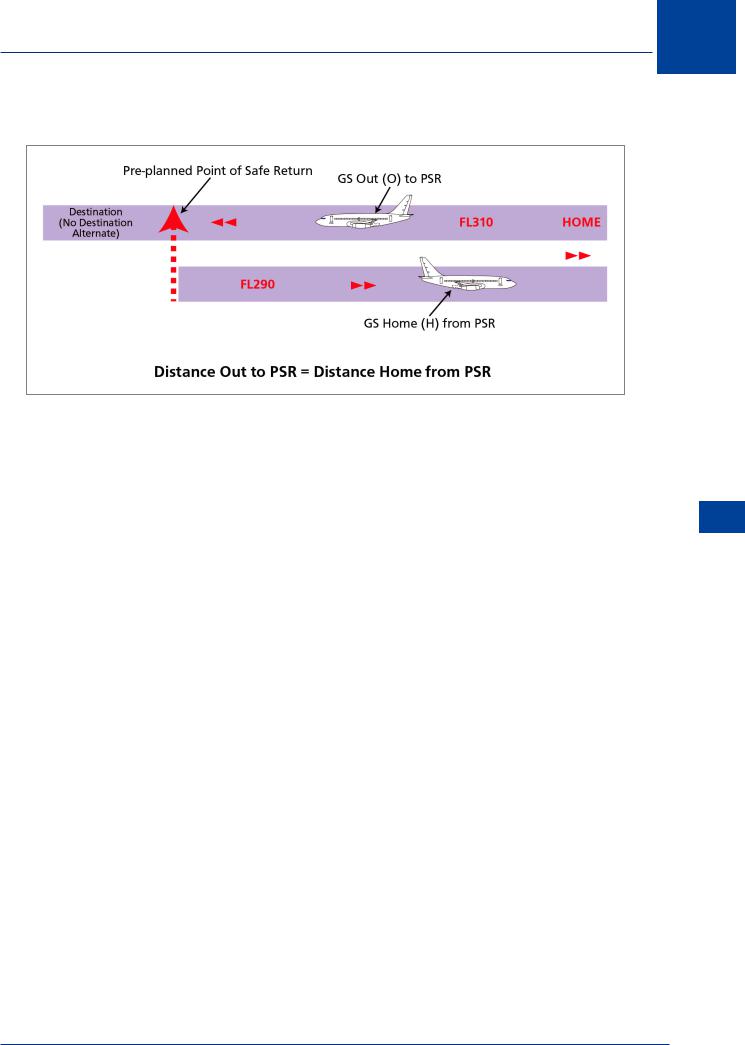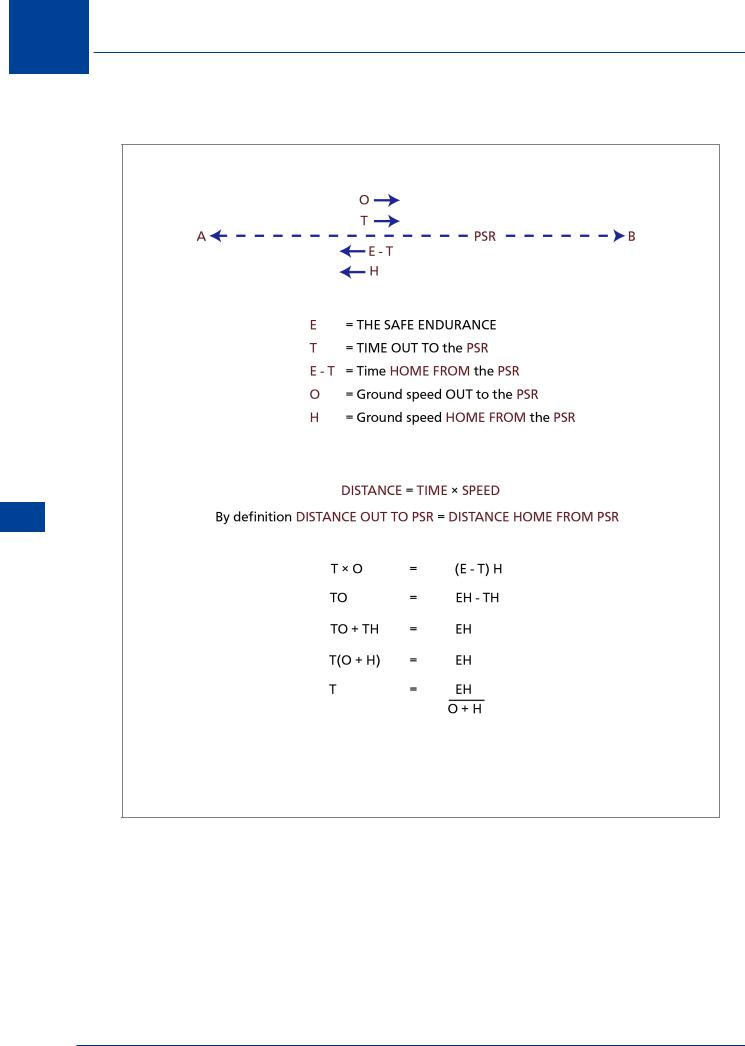
- •Textbook Series
- •Contents
- •1 Air Information Publications
- •Introduction
- •Format of an AIP
- •Automatic Terminal Information Service (ATIS)
- •Aerodrome Communication Facilities
- •Aerodrome Radio Navigation and Landing Aids
- •Other Sources
- •Search and Rescue
- •Questions
- •Answers
- •2 Fuel Policy and Fuel Monitoring
- •Universal Application of Fuel Policy
- •Realistic Trip Fuel
- •Reserve Fuel
- •Calculation of Contingency Fuel
- •Fuel Monitoring
- •Special Cases 1 – Decision Point Procedure
- •Special Cases 2 – Isolated Aerodrome Procedure
- •Questions
- •Answers
- •3 Nautical Air Miles
- •Nautical Air Miles
- •Questions
- •Answers
- •4 Single-engine Piston Aeroplane (SEP)
- •Introduction
- •Single-engine Piston Aeroplane
- •Cruise Power Settings Tables
- •Range Profile Figure
- •Endurance
- •Questions
- •Answers
- •5 Multi-engine Piston Aeroplane (MEP)
- •Introduction
- •MEP 1-Fuel, Time and Distance to Climb Data
- •MEP 1-Range at Standard Temperatures
- •MEP 1-Cruise Power Setting and Fuel Flow
- •MEP 1-True Airspeed
- •MEP 1-Endurance
- •MEP 1-Descent Fuel, Time and Distance
- •Questions
- •Answers
- •Introduction
- •Aeroplane Data and Constants
- •Optimum Cruise Altitude
- •Short Distance Cruise Altitude
- •Answers to Simplified Flight Planning
- •Questions
- •Answers
- •En Route Climb
- •Cruise/Integrated Range Tables
- •Questions
- •Answers
- •Descent Table
- •Exercise 1
- •Exercise 2
- •Answers to Integrated Flight Planning
- •8 MRJT Additional Procedures
- •ETOPS – CAP 697 MRJT1
- •Non-normal Operations
- •Fuel Tankering
- •Answers
- •9 Topographical Chart
- •Introduction
- •World Geodetic System of 1984 (WGS84)
- •Aeronautical Information
- •Topographical Information
- •Miscellaneous
- •Establishment of Minimum Flight Altitudes
- •The Minimum Grid Area Altitudes (Grid MORA)
- •Choosing Cruising Levels
- •Altimeter Errors and Corrections
- •Exercise 1
- •VFR Exercise 2
- •Answers
- •Exercise 1 Answers
- •VFR Exercise 2 Answers
- •10 Airways
- •Introduction
- •Air Traffic Services (ATS) Routes/Standard Routes
- •Area, Low and High Level Charts
- •Exercise 1
- •Exercise 2
- •Answers to Examples/Exercises
- •Answers Exercise 1
- •Answer Airways Exercise 2
- •Projection
- •Track Direction/Magnetic Variation/Distance
- •Grid Navigation
- •Exercise 1
- •Answers to Exercise 1
- •Exercise 2
- •Answers
- •AT(H/L) 1 & 2 Information
- •Exercise 3
- •12 ATC Flight Plan
- •Introduction
- •Definitions
- •Annexes to This Chapter
- •Specimen CA48
- •Item 19: Supplementary Information
- •Item 15
- •Use of DCT (Direct)
- •Exercise 1
- •Exercise 2
- •Exercise 3
- •Exercise 4
- •Answers
- •Annex 2
- •13 Point of Equal Time (PET)
- •Introduction
- •Derivation of Formula
- •The Effect of Wind on the Position of the PET:
- •Single Sector All-engine PET
- •Engine Failure PET
- •14 Point of Safe Return (PSR)
- •Introduction
- •Derivation of the Formula
- •Transposing the Formula to the Navigation Computer
- •The Effect of Wind on the Location of the PSR
- •Single Leg PSR
- •Derivation of the Formula for Variable Fuel Flows
- •15 Revision Questions
- •Revision Questions
- •Answers to Revision Questions
- •Specimen Examination Paper
- •Answers to Specimen Examination Paper
- •Explanations to Specimen Examination Paper
- •16 Index

Chapter
14
Point of Safe Return (PSR)
Introduction |
|
|
|
|
|
|
|
259 |
Derivation of the Formula . . . . . . . . . . |
. . |
. . |
. . |
. . |
. . |
. . |
. . . |
260 |
Transposing the Formula to Navigation Computer |
|
|
|
|
|
|
|
261 |
The Effect of Wind on the Location of the PSR |
|
|
|
|
|
|
|
261 |
Single Leg PSR |
|
|
|
|
|
|
|
262 |
Questions - Single Leg PSR . . . . . . . . . . |
. . |
. . |
. . |
. . |
. . |
. . |
. . . |
263 |
Answers - Single Leg PSR . . . . . . . . . . |
. . |
. . |
. . |
. . |
. . |
. . |
. . . . |
265 |
Derivation of the Formula for Variable Fuel Flows . |
. . |
. . |
. . |
. . |
. . |
. . |
. . . . 266 |
|
Example Variable Fuel Flows PSR - Single Sector . . |
. . |
. . |
. . |
. . |
. . |
. . |
. . . |
266 |
Questions - PSR with Fuel |
|
|
|
|
|
|
|
267 |
Answers - PSR with Fuel . . . . . . . . . . |
. . |
. . |
. . |
. . |
. . |
. . |
. . . . |
268 |
Questions - All Types . . . . . . . . . . . . |
. . |
. . |
. . |
. . |
. . |
. . |
. . . |
269 |
Answers - All Types . . . . . . . . . . . . |
. . |
. . |
. . |
. . |
. . |
. . |
. . . . |
270 |
257

14 Point of Safe Return (PSR)
(PSR) Return Safe of Point 14
258

Point of Safe Return (PSR) 14
Introduction
Figure 14.1 Point of safe return
The POINT OF SAFE RETURN (PSR), previously referred to as the POINT OF NO RETURN (PNR), is the furthest point along a planned route to which an aircraft can fly and return to the departure airfield, or departure alternate, within the SAFE ENDURANCE of the aircraft. SAFE ENDURANCE is the length of time an aircraft can fly without consuming the mandatory reserves of fuel that are required overhead its departure airfield, or departure alternate, in the event of the aircraft returning from the PSR. This SAFE ENDURANCE, quoted as a period of time (or an amount of fuel) is used to calculate the PSR. It must not be confused with the TOTAL ENDURANCE, the time an aircraft can remain airborne, at the end of which the tanks are empty.
If the state of the weather, runway, let-down aids or political situation at a destination airfield is likely to deteriorate and the only recourse would be to return back to the departure airfield, or departure alternate, it is prudent to calculate a PSR. Normally, the calculation of a PSR would only be necessary for flights to an “isolated destination and no adequate destination alternate exists”. Occasions on which a PSR may be required might include flights from mainland airfields to destinations such as Easter Island, Cocos Island, Tahiti, Ascension Island and the Azores.
In flight, at a reasonable time before the ETA for the PSR, the pilot checks that the destination airfield’s weather, landing aids and runway state are acceptable for a period of usually one hour before to one hour after the destination ETA.
The distance OUT to the PSR equals the distance HOME from the PSR. The time OUT to the PSR and time HOME from the PSR will be the same in zero wind; if there is an overall wind component the time OUT and time HOME will be unequal. But, in each case, the two values total the Safe Endurance time.
Point of Safe Return (PSR) 14
259

14 Point of Safe Return (PSR)
Derivation of the Formula
(PSR) Return Safe of Point 14
Figure 14.2 Derivation PSR formula
260
